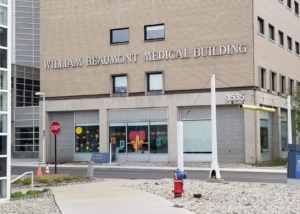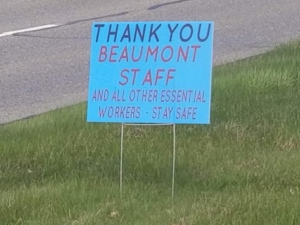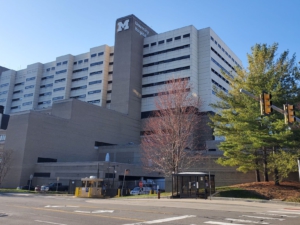As I write this, only ten countries in the world have surpassed Michigan in their total number of COVID-19 deaths. Michigan, a state with a population of less than 10 million people, has exceeded Canada’s number of cases confirmed today. Wayne County, which houses Detroit, has surpassed the entire state of California in total number of deaths, and has nearly eclipsed Brazil as well. At Sinai-Grace Hospital in Detroit, images have recently surfaced of human bodies being stored in vacant hospital rooms, stacked atop each other due to lack of space. At least two people in that hospital have died waiting in the emergency room hallways. The Oakland County Medical Examiner’s Office is considering using ice rinks in the Metro Detroit area as provisional morgues. Over one million people have applied for unemployment, placing the joblessness rate at 25 percent (the highest in the nation.) How, in a major city in the richest country ever to exist in human history, could this happen?
Michigan Governor Gretchen Whitmer’s efforts, including an initial March 16 to March 30 shutdown of bars and restaurants and a stay-at-home order which has been extended to reach to May 1, have succeeded somewhat in flattening the infection curve, but have been significantly less effective in preventing deaths than similar measures in other states with higher population densities and more urban centers. To explain why Michigan has been so hard-hit by the novel coronavirus, we have to understand austerity, racial capitalism and the legacy of policies enacted well before anyone had ever heard of COVID-19.
The role of austerity
In 2016, Abdul El-Sayed, executive director of the Detroit Health Department, when describing the issues at the root of a recent Hepatitis A outbreak, had this to say:
“It all comes down to government austerity, and the inability or lack of foresight to invest in public goods, which then allows infectious disease to spread.”
— Abdul El-Sayed, Executive Director, Detroit Health Department
Austerity, a type of economic policy that slashes public funding, increases taxes on workers and privatizes public institutions to enrich the ruling class, is integral to understanding the struggle against the novel coronavirus.
In Detroit, the center of Michigan’s crisis, austerity has been utterly vicious. Although austerity in Detroit arguably began in the 1960s with white flight and the decimation of the city’s tax base, most recent analyses focus on the aftermath of the bankruptcy declaration of 2014, which was the largest municipal bankruptcy in U.S. history.
The bankruptcy, widely touted as a lifeline for the city, was in fact a Trojan horse for an enormous heist perpetrated by the ruling class upon the working class. Public schools, housing, water and other essential programs and services were on the chopping block. Enormous amounts of land and housing previously owned by Black people was bought by landlords, and the gentrification of the city accelerated at a dizzying pace. This represented a massive decline in wealth for working Black families; Black America had already seen 61 percent of its wealth stolen in the economic crisis of 2008, and what wealth remained after 2008 was largely connected to home ownership. Many families who had lived in Detroit for decades were forced into other communities, and the homeless rate increased to more than 14,000 people.

The austerity agenda implemented under Michigan Governor Rick Snyder greatly decreased the resiliency of Detroit and of Michigan as a whole. Risk factors for COVID-19 like poverty (which currently stands at 40 percent in the city), homelessness and lack of access to clean water were greatly increased. The austerity agenda did not end with Snyder’s administration. In October 2019, Governor Gretchen Whitmer slashed 171 million dollars in funding for hospitals, targeting rural hospitals and nursing homes in particular. At present, 35 percent of all COVID-19 deaths in Wayne County have been in nursing homes.
Every nursing home in Genesee County and Detroit has at least one confirmed COVID-19 case. Relaively little attention has been afforded by the media to the ongoing crisis in rural Michigan, where hospitals and medical centers are routinely understaffed and underfunded, and many have shockingly inadequate access to mechanical ventilators.
On April 14, Detroit Mayor Mike Duggan called for even further cuts to essential services and layoffs or furloughs for even more workers. On April 21, Beaumont Health, one of Michigan’s largest hospital systems, announced layoffs for 2,475 workers, and the permanent elimination of 450 more positions. The move is blatantly irresponsible, considering that nurses in the Metro Detroit area are already severely overwhelmed. Beaumont executives justified their actions by citing the financial damage incurred by performing reduced numbers of profitable elective surgeries. In this new economic depression, it is likely that even more austerity measures will be advanced by the ruling class, further exacerbating the coronavirus crisis.
Role of water crisis in fueling COVID-19
The Detroit water crisis resulting from shutoffs dictated by the emergency manager has undoubtedly contributed to Detroit becoming a COVID-19 hotspot. Thousands of homes in Detroit and Michigan at large still have no access to running water, even with the implementation of the city’s “Coronavirus Water Restart” program and Governor Whitmer’s executive order to reconnect water service for all Michigan residents. A lack of clean water presents obvious problems in a pandemic; many Detroit residents have no easy way to disinfect their hands, being forced to make do with bottled water, or else find their way to one of the city’s six makeshift handwashing stations. The state has left many Michiganders without the means to follow even the most basic guidelines for preventing COVID-19 transmission, and yet many of our elected officials feign surprise at the rapid spread of the disease.
The environmental factors of life in Michigan, especially in the most urbanized areas, contribute significantly to the damage wrought by the pandemic.
Until July 2019, Detroit was home to the world’s largest municipal incinerator. It was only shuttered because of a decades-long campaign by grassroots organizations like Breathe Free Detroit and Zero Waste Detroit. Originally established in 1986 by the city government in hopes that it would bring new industries and better jobs, the incinerator only served to worsen the health of the people forced to live in its shadow.
For 33 years, communities near the incinerator were subject to toxic emissions, causing a wide range of respiratory problems including asthma and lung disease. Detroiters as a whole are three times more likely to be hospitalized for an asthma attack than other Michigan residents. The negative environmental consequences of Detroit’s manufacturing industry, past and present, fall directly on the most vulnerable people. Over three dozen pollution-generating facilities in Detroit are known to cause heart disease, cancer, asthma and other respiratory problems. Environmental racism is directly linked to many of the pre-existing conditions that make Detroiters more susceptible to contracting COVID-19.
Racism kills
As many of us know by now, the impact of the novel coronavirus pandemic is distributed extremely unequally along racial lines. While Black Michiganders comprise only 14 percent of the state, we make up 33 percent of confirmed COVID-19 cases and 40 percent of deaths. Over 80 percent of Michigan’s coronavirus cases are located in Metro Detroit, which is one of the most segregated metro areas in the nation. In Detroit, the risk of diabetes for Black people is 77 percent higher than it is for white people. Lack of access to health care is a serious concern, with 11.1 percent of Detroit residents uninsured and many more receiving substandard care.
Black Michiganders are largely critical infrastructure workers, doing jobs in health care, grocery stores, transportation, construction, postal services and manufacturing. Black Michiganders are also disproportionately incarcerated. The virus has been proven to spread frighteningly fast through jails and prisons. Roughly one in three Detroit workers takes the bus to work, which increases their risk. For these reasons and more, the situation in Michigan demanded a response that took into account the massive disparities in health and work between Black and white Michiganders, and the state has failed us altogether. It’s easy to conclude that institutional white supremacy has been central to Michigan’s failings in handling the COVID-19 pandemic.
Indigenous people in Michigan have also been hard-hit by the COVID-19 crisis. The Sault Ste. Marie Tribe of Chippewa Indians, the largest tribe east of the Mississippi with more than 40,000 enrolled members, had only two testing kits made available to them as late as March 21. Their health centers are overwhelmed, and many other tribes are lacking the essential personal protective equipment that medical professionals need to safely perform their jobs.
Indigenous people are subject to environmental racism, much the same as Black people. Higher incidences of asthma, heart disease and diabetes make Indigenous people a high-risk population. The tribe itself is often the main health care provider for Indigenous people, but the federal and state governments, as well as the local health departments, are not fulfilling their obligations with respect to the provisional needs of many tribes. In accordance with treaties, the United States government has a responsibility to provide tribes with assistance commensurate with their population. While Indigenous people in the United States make up two percent of the population, only 0.5 percent of the two trillion dollar coronavirus relief package signed into law on March 27 is allotted for tribal governments.
Heroic worker resistance

Amidst the discouraging stories about the failure of the federal response to the crisis and the rising numbers of cases, there are some stories of heroic worker resistance. Detroit bus drivers initiated a one-day work stoppage with the support of their union and won safety precautions for drivers and riders, as well as free bus fares. At Detroit Medical Hospital, where one nurse may be treating 20 or more patients at a time, nurses organized a sit-in to demand better protections and more support to allow them to better handle the COVID-19 surge.
At Sinai-Grace Hospital, seven night-shift emergency room nurses staged a sit-in, demanding that more nurses be sent in to help. At the Amazon fulfillment center in Romulus, Michigan, after a worker tested positive for COVID-19, more than 40 workers took part in a demonstration to demand more protections from the virus. These kinds of demonstrations will need to be organized more often, with more support from our class, and with even bolder demands.

The ruling class has made it clear; their first and last concern is profit, and they are interested in substantively addressing the pandemic only insofar as they can profit from it. Already, before many of the hotspots in the country have even reached their peak of new cases, the capitalists and their politicians are discussing reopening the economy. The proposals to reopen in the near term are widely derided among public health officials, whose evidence says that we risk a massive resurgence in cases and the overload of the U.S. health care system if we attempt to end the lockdown protocol too soon.
Michigan’s already overwhelmed and severely underfunded hospitals would be even less able to address the pandemic. We must all be aware that the COVID-19 pandemic will only be defeated by the working class. We should know that in order to defeat not only the pandemic but also secure a future in which the privations we now experience will become impossible, we must be more radical. We will have to get at the roots of the problem: capitalism, austerity and white supremacy. We must protect our most vulnerable populations. We will deepen and broaden the struggle, lending support to those who are already fighting and bringing new people into the class war. We will overturn the system of capitalism and institute a system where people’s lives and basic needs will take precedence over profit. We have nothing to lose but our chains!





